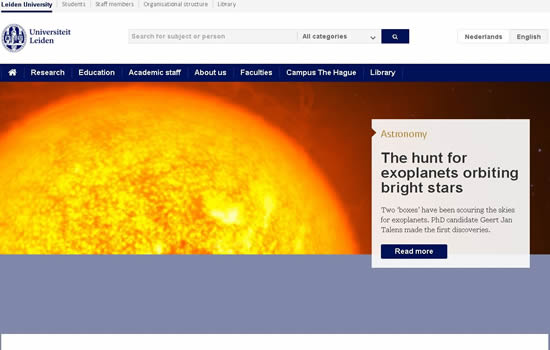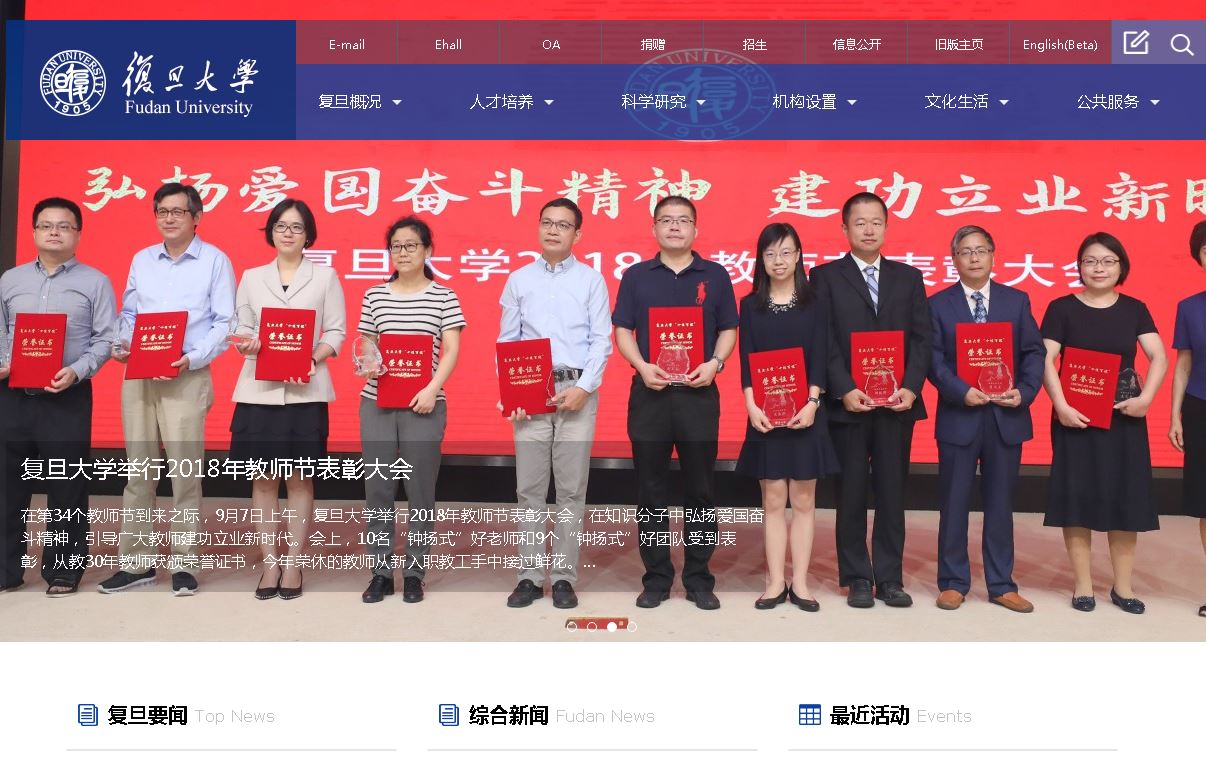选择热点
 荷兰莱顿大学
荷兰莱顿大学 西班牙巴塞罗那大学
西班牙巴塞罗那大学 巴西圣保罗大学 University of Sao Paulo, Brazil
巴西圣保罗大学 University of Sao Paulo, Brazil 台湾南华大学 University of South China in Taiwan
台湾南华大学 University of South China in Taiwan 科技大学 National University of Defense Technology
科技大学 National University of Defense Technology 南京大学 Nanjing University
南京大学 Nanjing University 上海复旦大学 Fudan University
上海复旦大学 Fudan University 泗水大学(Ubaya)
泗水大学(Ubaya) 印尼大学 universitas indonesia
印尼大学 universitas indonesia 越南某大学 Vietnam National University
越南某大学 Vietnam National University 菲律宾大学 University Of The Philippines
菲律宾大学 University Of The Philippines
冠状病毒能被温暖的天气击溃吗?
发布时间:2025-01-06
来源:大学网站
Can Coronavirus Be Crushed By Warmer Weather?
冠状病毒能被温暖的天气击溃吗?
There's a seasonality to many viruses.
Flu and cold viruses tend to peak in winter months, then die down with warmer weather.
许多病毒都有季节性。
流感和感冒病毒往往在冬季达到高峰,然后随着天气变暖而逐渐消失。
Will the newly identified coronavirus and the disease it causes — COVID-19 — follow a similar pattern?
新发现的冠状病毒和它引起的疾病COVID-19会遵循类似的模式吗?
Before that question can be answer, let's consider how seasons and temperature influence the spread of viruses.
在回答这个问题之前,让我们考虑一下季节和温度如何影响病毒的传播。
"Coronaviruses tend to be associated with winter because of how they're spread," explains Elizabeth McGraw, who directs the Center for Infectious Disease Dynamics at Pennsylvania State University.
For one thing, in winter months, people may cluster together more indoors, increasing the number of folks at risk of becoming infection by someone who's contagious.
由于冠状病毒的传播性,所以往往与冬季有关,”宾夕法尼亚州立大学传染病动力学中心主任伊丽莎白·麦格劳解释说。
首先,在冬季,人们可能会更多地聚集在室内,增加了被有传染性的人感染的风险。
In addition, there's the matter of transmission.
Viruses spread through respiratory droplets that are released when an infected person coughs or sneezes.
And the droplets are more likely to spread under certain conditions.
此外,还有传播的问题。
病毒通过被感染者咳嗽或打喷嚏时释放的飞沫传播。
液滴在一定条件下更容易扩散。
"What we know is that they're [the droplets] are better at staying afloat when the air is cold and dry, " says McGraw.
"When the air is humid and warm, [the droplets] fall to the ground more quickly, and it makes transmission harder.
"我们所知道的是,当空气寒冷干燥时,它们(水滴)更能保持漂浮,”麦格劳说。
当空气潮湿而温暖时,(水滴)降落到地面的速度更快,传播也更困难。
”Not every coronavirus hews to the same rules.
For instance, the one that causes Middle East Respiratory Syndrome (MERS) has not shown the capacity to spread easily from person to person, says Amesh Adalja, an infectious disease physician and a senior scholar at the Johns Hopkins Center for Health Security: "It doesn't have that seasonality because it's really an animal to human virus and not something that that you see causing disease in a seasonal pattern.
"并不是每一种冠状病毒都遵守同样的规则。
例如,引起中东呼吸综合征(MERS)的一种病毒并没有显示出在人与人之间容易传播的能力,传染病内科医生、约翰·霍普金斯健康安全中心高级学者阿梅什·阿达尔贾说:它没有季节性,因为它实际上是一种动物传人的病毒,而不是你认为的季节性致病病毒。
”But he says COVID-19 seems more akin to the seasonal cold.
And up to a third of common colds are caused by coronaviruses.
但他表示,COVID-19似乎更类似于季节性寒冷。
高达三分之一的普通感冒是由冠状病毒引起的。
"We've seen, basically, explosive spread inside China of person-to-person transmission, so — in that sense — it really is behaving like a common-cold causing coronavirus," says Adalja.
阿达尔贾说:我们已经看到,在中国国内,基本上是人传人的爆发性传播,所以,从这个意义上说,它确实表现得像导致普通感冒的冠状病毒。
”For that reason, he says, "I do think seasonality will play a role.
As this outbreak unfolds and we approach spring and summer, I do think we will see some tapering off of cases.
"出于这个原因,他说,我确实认为季节性将发挥作用。
随着疫情的展开,我们将接近春季和夏季,我确实认为我们将看到病例有所减少。
”So as China and the rest of the Northern Hemisphere head into spring, the virus could begin to peter out or plateau.
But the southern half of the globe is headed into fall and winter "so we may see this [virus] have increased transmission" in parts of the southern hemisphere, says Adalja — for example, in Australia.
That's similar to what happens with the flu each year.
因此,随着中国和北半球其他国家迈入春季,病毒可能会开始逐渐消失或停滞不前。
但是,阿达尔贾说,地球的南半部正在进入秋季和冬季,所以我们可能会看到这种[病毒]在南半球的部分地区增加了传播”,例如在澳大利亚。
这与每年流感的情况相似。
"It's not unreasonable to make the assumption" that cases will die down come spring, Dr.
Anthony Fauci, director of the National Institute of Allergy and Infectious Diseases, told NPR.
"We hope when the weather gets warmer it will diminish a bit," he says.
美国国家过敏和传染病研究所所长安东尼·福奇博士在接受美国国家公共电台采访时表示,认为明年春天过敏病例会减少并不是没有道理的”。
他说:我们希望当天气变暖时,它会减少一点。
”But he sounds a cautionary note: "However, we don't know that about this [new] coronavirus.
We don't have [a] backlog of history.
"但他发出了警告:然而,我们对这种(新的)冠状病毒并不了解。
我们没有积压的历史。
”Dr.
Nancy Messionnier of the Centers for Disease Control and Prevention sounds a similar note when it comes to predicting a slowdown of cases with warmer weather.
"I think it's premature to assume that," she said during a call with reporters on Wednesday.
"We haven't been through even a single year with this pathogen.
"当谈到天气变暖时,疾病控制和预防中心的南希·梅西奥尼耶博士听起来也有类似的说法。
她在周三与记者的电话会议中表示:我认为现在断定这一点还为时过早。
”我们甚至一年都没有感染过这种病原体。
”Given the uncertainty, public health officials say they must plan for the unexpected and for the possibility that the outbreak drags on regardless of the weather.
鉴于不确定性,公共卫生官员表示,他们必须为意想不到的情况做好计划,并考虑到无论天气如何,疫情都可能会持续下去。
【冠状病毒能被温暖的天气击溃吗?查看网站:[db:时间]】
冠状病毒能被温暖的天气击溃吗?
There's a seasonality to many viruses.
Flu and cold viruses tend to peak in winter months, then die down with warmer weather.
许多病毒都有季节性。
流感和感冒病毒往往在冬季达到高峰,然后随着天气变暖而逐渐消失。
Will the newly identified coronavirus and the disease it causes — COVID-19 — follow a similar pattern?
新发现的冠状病毒和它引起的疾病COVID-19会遵循类似的模式吗?
Before that question can be answer, let's consider how seasons and temperature influence the spread of viruses.
在回答这个问题之前,让我们考虑一下季节和温度如何影响病毒的传播。
"Coronaviruses tend to be associated with winter because of how they're spread," explains Elizabeth McGraw, who directs the Center for Infectious Disease Dynamics at Pennsylvania State University.
For one thing, in winter months, people may cluster together more indoors, increasing the number of folks at risk of becoming infection by someone who's contagious.
由于冠状病毒的传播性,所以往往与冬季有关,”宾夕法尼亚州立大学传染病动力学中心主任伊丽莎白·麦格劳解释说。
首先,在冬季,人们可能会更多地聚集在室内,增加了被有传染性的人感染的风险。
In addition, there's the matter of transmission.
Viruses spread through respiratory droplets that are released when an infected person coughs or sneezes.
And the droplets are more likely to spread under certain conditions.
此外,还有传播的问题。
病毒通过被感染者咳嗽或打喷嚏时释放的飞沫传播。
液滴在一定条件下更容易扩散。
"What we know is that they're [the droplets] are better at staying afloat when the air is cold and dry, " says McGraw.
"When the air is humid and warm, [the droplets] fall to the ground more quickly, and it makes transmission harder.
"我们所知道的是,当空气寒冷干燥时,它们(水滴)更能保持漂浮,”麦格劳说。
当空气潮湿而温暖时,(水滴)降落到地面的速度更快,传播也更困难。
”Not every coronavirus hews to the same rules.
For instance, the one that causes Middle East Respiratory Syndrome (MERS) has not shown the capacity to spread easily from person to person, says Amesh Adalja, an infectious disease physician and a senior scholar at the Johns Hopkins Center for Health Security: "It doesn't have that seasonality because it's really an animal to human virus and not something that that you see causing disease in a seasonal pattern.
"并不是每一种冠状病毒都遵守同样的规则。
例如,引起中东呼吸综合征(MERS)的一种病毒并没有显示出在人与人之间容易传播的能力,传染病内科医生、约翰·霍普金斯健康安全中心高级学者阿梅什·阿达尔贾说:它没有季节性,因为它实际上是一种动物传人的病毒,而不是你认为的季节性致病病毒。
”But he says COVID-19 seems more akin to the seasonal cold.
And up to a third of common colds are caused by coronaviruses.
但他表示,COVID-19似乎更类似于季节性寒冷。
高达三分之一的普通感冒是由冠状病毒引起的。
"We've seen, basically, explosive spread inside China of person-to-person transmission, so — in that sense — it really is behaving like a common-cold causing coronavirus," says Adalja.
阿达尔贾说:我们已经看到,在中国国内,基本上是人传人的爆发性传播,所以,从这个意义上说,它确实表现得像导致普通感冒的冠状病毒。
”For that reason, he says, "I do think seasonality will play a role.
As this outbreak unfolds and we approach spring and summer, I do think we will see some tapering off of cases.
"出于这个原因,他说,我确实认为季节性将发挥作用。
随着疫情的展开,我们将接近春季和夏季,我确实认为我们将看到病例有所减少。
”So as China and the rest of the Northern Hemisphere head into spring, the virus could begin to peter out or plateau.
But the southern half of the globe is headed into fall and winter "so we may see this [virus] have increased transmission" in parts of the southern hemisphere, says Adalja — for example, in Australia.
That's similar to what happens with the flu each year.
因此,随着中国和北半球其他国家迈入春季,病毒可能会开始逐渐消失或停滞不前。
但是,阿达尔贾说,地球的南半部正在进入秋季和冬季,所以我们可能会看到这种[病毒]在南半球的部分地区增加了传播”,例如在澳大利亚。
这与每年流感的情况相似。
"It's not unreasonable to make the assumption" that cases will die down come spring, Dr.
Anthony Fauci, director of the National Institute of Allergy and Infectious Diseases, told NPR.
"We hope when the weather gets warmer it will diminish a bit," he says.
美国国家过敏和传染病研究所所长安东尼·福奇博士在接受美国国家公共电台采访时表示,认为明年春天过敏病例会减少并不是没有道理的”。
他说:我们希望当天气变暖时,它会减少一点。
”But he sounds a cautionary note: "However, we don't know that about this [new] coronavirus.
We don't have [a] backlog of history.
"但他发出了警告:然而,我们对这种(新的)冠状病毒并不了解。
我们没有积压的历史。
”Dr.
Nancy Messionnier of the Centers for Disease Control and Prevention sounds a similar note when it comes to predicting a slowdown of cases with warmer weather.
"I think it's premature to assume that," she said during a call with reporters on Wednesday.
"We haven't been through even a single year with this pathogen.
"当谈到天气变暖时,疾病控制和预防中心的南希·梅西奥尼耶博士听起来也有类似的说法。
她在周三与记者的电话会议中表示:我认为现在断定这一点还为时过早。
”我们甚至一年都没有感染过这种病原体。
”Given the uncertainty, public health officials say they must plan for the unexpected and for the possibility that the outbreak drags on regardless of the weather.
鉴于不确定性,公共卫生官员表示,他们必须为意想不到的情况做好计划,并考虑到无论天气如何,疫情都可能会持续下去。
【冠状病毒能被温暖的天气击溃吗?查看网站:[db:时间]】
- 上一篇: 被隔离的生活:从武汉撤离的美国人的生活
- 下一篇: 中国将调查“吹哨人”医生死于冠状病毒后的情况
相关阅读
目录列表
资讯列表
英语资讯


共0条评论
网友评论温馨提示:您的评论需要经过审核才能显示,请文明发言!